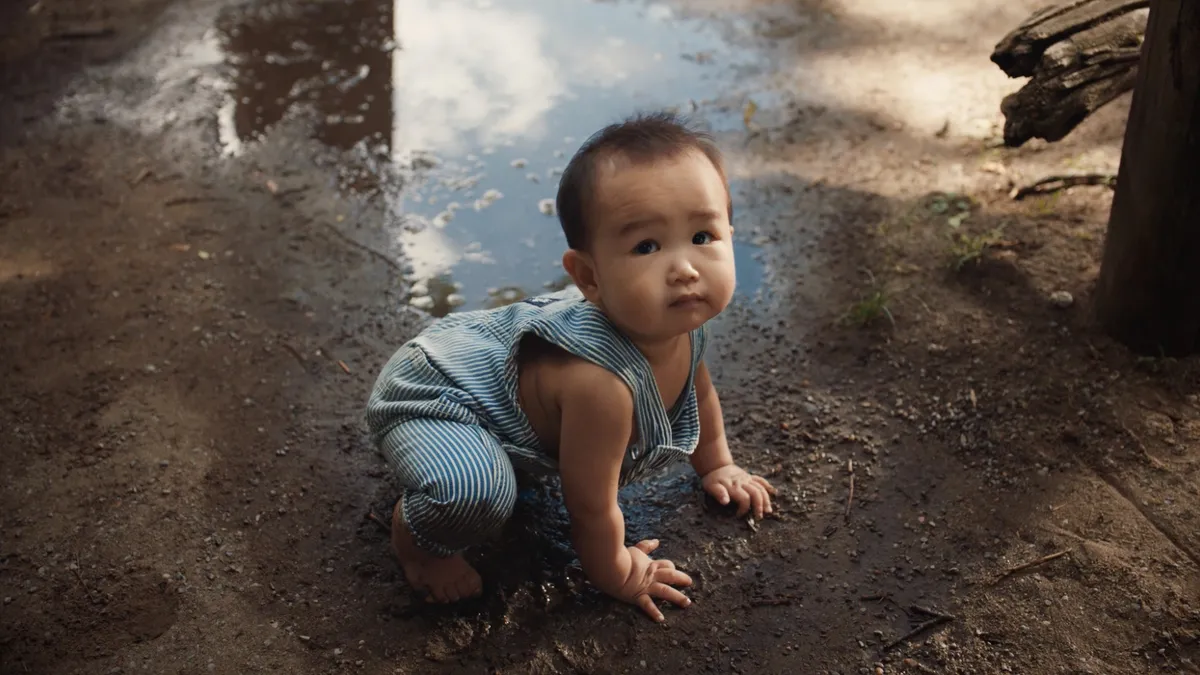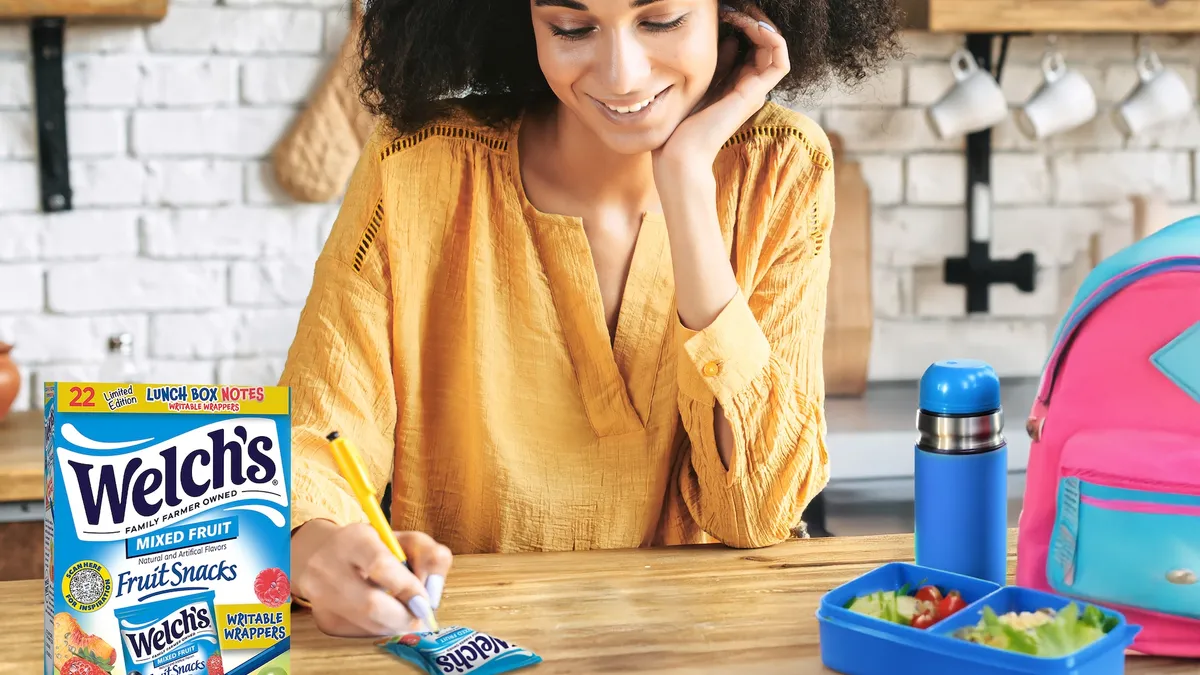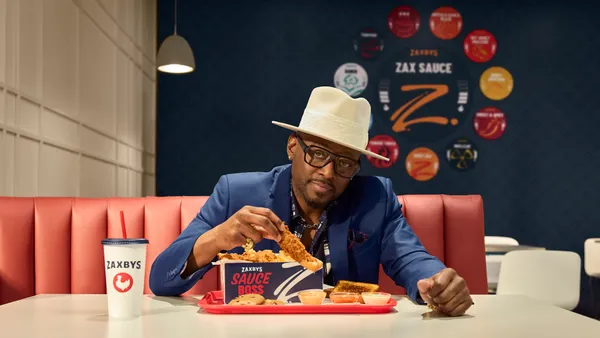UPDATE: Nov. 8, 2024: Carter’s has released three more six-second ads as part of the “More Than Just Cute” campaign, per details shared with Marketing Dive. The holiday- and winter-themed spots, “Who is this Guy,” “Best Behavior” and “Layers” will run on YouTube, Instagram, Facebook and TikTok.
As parents and their children prepare for the back-to-school season, Carter’s is launching a campaign with creative focused on the youngest kids that it outfits. “More Than Just Cute,” the first work from the apparel brand’s partnership with agency Mischief, looks beyond “cute” to spotlight the fits and functions preferred by young parents in the millennial and Gen Z age range (the oldest members of the latter cohort are in their late 20s, after all).
A 30-second hero spot, “All I Am,” includes voiceover stating that “cute is too superficial” to describe an infant. The narrator goes on to dryly list “accomplishments” like crawling in the mud and playing with apple sauce.
“Don’t settle for just cute,” the narrator adds. “You’re more than that.”
“All I Am” and a handful of 6-second videos that key in on specific kid actions — like pushing a glass of red wine onto the carpet — are running across broadcast and social platforms, including Facebook, TikTok, Instagram, Pinterest and YouTube. For 160-year-old Carter’s, which bills itself as the largest North American baby and children’s apparel company, the campaign debuting Thursday (Aug. 1) represents an attempt to reach a new generation of parents.
“How do we create this campaign that really redefines us as a brand, that leans on all the things that we’re known for — our durability, our quality, our comfort — and showcases the product and a brand through a new lens, but still leans into the history of the company?” CMO Jeff Jenkins said of the needs of the campaign.
Jenkins spoke with Marketing Dive about “More Than Just Cute,” key insights about Gen Z consumers, how Carter’s approaches loyalty and more.
The following interview has been edited for clarity and brevity.
MARKETING DIVE: What drove the creation of the “More Than Just Cute” campaign?
JEFF JENKINS: It really started with data and insights about how the consumer is changing, what those expectations are and then finding a partner that was right for us as we shifted directions. Mischief came on board and I think the challenge that we gave them was: The consumer is changing — more Gen Z is becoming parents and they have a different expectation of a brand — and the baby clothes category is changing.
Kids clothes used to be all about being cute. Now it’s about being stylish and “mini mes” and [representing] yourself on social media as a parent. The challenge that we threw to Mischief was, we want to make sure that we’re pushing the envelope forward in our category, that we’re not thinking about how the category behaves, but how the consumer behaves. We want to make sure that we push the brand in places that are uncomfortable, but not unnatural. Gen Z and millennials, we scroll all day, and so a traditional ad gets scrolled right by — how do we create thumb-stopping content in that context?
A generational shift has gone from “cute” to “style,” and we’re more than [cute], we’re a brand there for every moment, not just the what I would call the Olan Mills or Lifetouch Photography moments of the ‘80s and ‘90s. We’re the brand that understands that for every post you do on Instagram, there are 99 outtakes on your phone that didn’t make it.
I think everyone saw little bits of themselves [in the campaign]. This is how consumers talk and behave, and it just resonated with every single insight that we handed over.
“Uncomfortable but not unnatural” makes me think of the campaign’s 6-second spot that shows a kid riding a bike right into a basketball post, and the voiceover about “durable fabrics [being] the only thing standing between kids’ butts and the world’s foot.” What was your approach on presenting familiar moments like that?
JENKINS: We’ve all taken those videos, which as soon as you realize the kid is okay, then it becomes funny. That’s the type of content you’re seeing on TikTok, Instagram Reels and YouTube Shorts. So much media has shifted to the creator space. It’s not the polished work of an ad agency.
Mischief has done a brilliant job of blending this traditional advertising model with this creator content-type of model, and then we pull it through into creator content that is being created on behalf of the brand, as well as all of our store experiences and billboards.
What are all those things that the next generation, whether it’s Gen Z, Gen Alpha or millennials, grew up with that is now informing their parenthood choices?
Speaking of short-form video, how did you approach the channel mix on this campaign?
JENKINS: We have a great partner in Assembly as our media agency. We were already heavily [invested] in a lot of the platforms that are part of the campaign, but how do we go deeper? How do we build out creator content that supports this in a new media economy? How do we be part of these are huge communities, whether you think about it as “MomTok” or “ParentingTok?” That’s where consumers are getting their information around brands, tips and tricks and hacks of surviving parenthood, so we need to be there and be part of that.
There’s still a place, though, in the media mix for these traditional channels. This has a huge billboard, out-of-home component to it. We’ve seen Gen Z and millennials to some degree have really gone back to the malls post-pandemic. Seventy percent of our sales go through stores, so what’s the experience when it comes to life in malls, where consumers are really shopping, particularly in our category where you touch and feel baby clothes when you’re a first time parent?
Carter’s revamped its loyalty program this year. How does that feed into the brand’s marketing?
JENKINS: It all ties together. Particularly in our category, we’re really lucky that if you buy a three-month-old bodysuit that has fire trucks on it, I can guarantee you’re probably going to be buying a six-month one in three months. We can get to this personalization journey in ways that others can’t. At Best Buy, you may buy a record player one month and a washing machine three years from now. We know this cadence.
Almost 90% of our sales go through our loyalty program. Compared to some of the industry averages from the key loyalty players in the space, like Starbucks, we’re at the top of the game, which gives us great insight to consumer behaviors and what they want.























